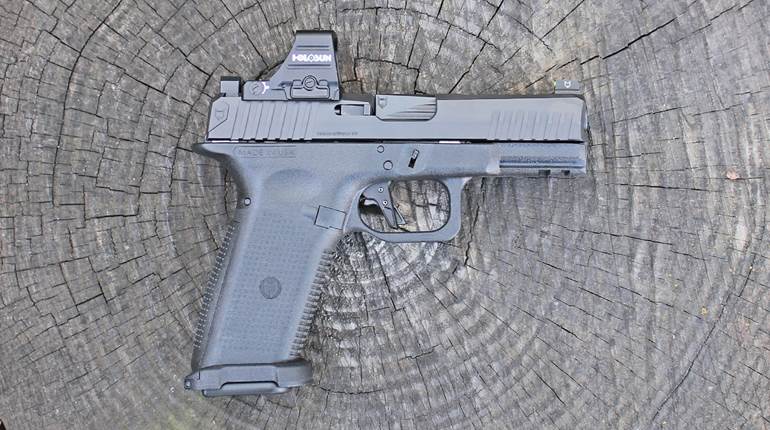
One of the trends evident in the 2012 market is an increase in the number of gun companies introducing suppressor-ready firearms or offering threaded barrels for installation in existing models. Although sound suppressors have been around since 1905, they remain a widely misunderstood and misrepresented shooting accessory. Since the industry is feeling suppressed this year, it seems like the right time to take a look into what sound suppressors are all about.
The Physics
When reducing the amount of sound produced by a firearm, two types of noise must be mitigated. The first is the sound made by the bullet as it flies through the air. If the bullet is traveling at a hyper-sonic speed, meaning a velocity faster than the 1,130 fps mark, then the bullet breaks the sound barrier and produces a small sonic boom. This is the distinctive "crack" produced by high-velocity rounds. The only way to eliminate this sonic signature is to reduce the speed of the bullet. Some calibers of ammunition already have a variety of factory loads pushing bullets out of the barrel at 1,000 fps or less. Other loads have bullet weights and powder charges specifically modified for slower flight. If you see ammunition labeled as "subsonic," then it's most likely been adapted for use with sound suppressors.
The second element of a firearm's report is the pressure wave created by the rapid expansion of propellant gases produced when a cartridge's powder charge ignites. As these hot, fast-moving gases collide with the cool, slow-moving air around the muzzle of the gun, they produce the familiar "bang" associated shooting. It's this portion of a gun’s noise that suppressors are designed to reduce.
The Mechanics
Generally speaking, a sound suppressor is a metallic tube that can be attached to the muzzle of a gun. The most common method of attaching the suppressor is to twist the base cap onto a barrel cut with pipe-like threads to match it. The interior of the suppressor is likely to contain two sound reducing sections. The first one, located closest to the barrel, is an expansion chamber which causes the propellant gases to expand and lose some of their energy. The second section is filled with a series of baffles. These are small barriers with holes cut into them to allow the bullet to safely pass through while deflecting, diverting and slowing the propellant gasses.
As with any other century-old technology, plenty of tinkering and experimentation with suppressor design has been conducted to produce better results. Some suppressors contain only baffles, while others are all expansion chamber. One of the more recent developments, thanks to computer-aided design and CNC machinery, is the use of what's known as a monolithic core. Instead of a series of small components stacked in the suppressor tube, the internal support structure and baffle stack are milled from a single piece of steel or aluminum that can be easily removed from the tube for cleaning.
During a visit to the Silencerco factory in West Valley City, Utah, I had the opportunity to meet with company founder and suppressor designer Mike Pappas. He explained that while suppressors appear to be simple devices, a great deal of thought and development go into their design. Too much sound reduction can cause conflicts in the gas flow, resulting in lousy accuracy, while not enough gas restriction results in too much noise. Handing me one of the company’s square-shaped Osprey suppressors, which features a monolithic core, Mike noted that literally hundreds of core designs were developed, tested and rejected before they found the right balance of features.
Along with a suppressor's internal hardware, another sound-reducing option is the practice of running a suppressor "wet." Earlier this year, I meet with Brooks Van Camerik of Thompson Machine to discuss what wet versus dry suppression is all about. The process of wetting a suppressor involves adding a sound dampening liquid to the suppressor's baffle stack to improve its noise-reducing capabilities.
The liquid works to slow and cool hot gases before they exit into the atmosphere. Common wetting compounds include gun lubricants, silicone gel and ordinary tap water. Brooks clarified that while all modern suppressors can be wetted, dedicated wet suppressors rely on the presence of liquid in the baffles to work properly. The advantage of dedicated wet suppressors, like the units provided by Thompson machine, is that they are smaller, lighter and more maneuverable than their dry counterparts.
Here is the most important thing to understand about suppressors: They are not "silencers" in the Hollywood-movie sense. Just as a car muffler reduces, but does not eliminate, the noise of the engine, a suppressor only reduces the noise of a gun. Certain caliber and suppressor combinations can be amazingly quiet, but they still sound like a gun going off.
You may be asking yourself, if I can't make my .308 rifle sound like an Aboriginal blow gun, or make my pistol sound like a kitten sneezing, then what's the point of adding a suppressor? The primary benefit of suppressors is hearing protection. Noise levels are commonly measured in decibels (db) with human speech occurring at 60 to 65db and sounds louder than 95db requiring hearing protection. A sound of 125db will cause ear pain and unprotected exposure at 140db or louder will result in permanent hearing loss. Most gun reports are 140db or louder. Suppressors can reduce the noise level by 20 to 30db, or even more in some cases. This greatly reduces the chances of permanent hearing loss and the accuracy skewing flinch caused by loud noise.
A suppressor can also measurably reduce muzzle flash and felt recoil. In regard to bullet velocity, most modern suppressors do not contain components that come into contact with the bullet to slow it down. Instead, a phenomenon known as “suppressor push” can increase the velocity of a bullet. It's not much of an increase but every little bit counts. Shooting really is more relaxing when the noise is reduced to a much more tolerable level. All in all, suppressors make a sensible addition to one's shooting accessories.
The Legalities
The commonly held belief is that, in the United States, sound suppressors are illegal for civilians to own or shoot with. This is not the case. Sound suppressors are not illegal, they are regulated. They became a regulated item under the National Firearms Act (NFA) of 1934. The Act was an attempt to curb the use of what were considered "gangster weapons" without instituting a ban in direct violation of the 2nd Amendment. Instead of making suppressors illegal to own, they became subject to a $200 excise tax and Federal registration. Today, the BATFE is in charge of managing suppressor related paperwork and transfers.
The process of legally acquiring a suppressor is not as difficult as you might suppose. It's comparable to obtaining a concealed-carry permit in some states. The process starts with verifying your eligibility to own a suppressor. You must be over the age of 21, be free of a criminal record and so on. You will need to determine if you live in one of the 39 states that allow individuals to own NFA-regulated items. Once you have this information, it's time to find a suppressor dealer in your area.
Your dealer will walk you through the local regulations and federal paperwork you will need to submit in order to proceed. This process can include various forms, fingerprint cards, passport photos, a citizenship declaration form and the acquisition of a signature from a chief law enforcement officer. Once the documentation is sent and fees submitted, plan to twiddle your thumbs for 2 to 4 months while the BATFE processes the request. When the approval is complete, make sure you understand the regulations for transporting and storing you new gun-quieting accessory, and then enjoy.
The Next Big Thing?
With the continued growth in popularity of tactical shooting, and with sight systems and tactical rail accessories well developed, it seems logical that the next kind of must-have-doo-dad for shooters to explore would be an item to attach to the gun's barrel. Shooting suppressed is one of those experiences that, once you've tried it, you won't be able to deny how fun it is. Now that I've had the opportunity to test drive several suppressors on a variety of guns, it's easy to see why they may be the next big thing.





































